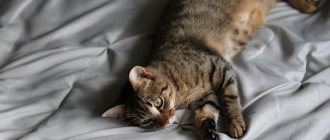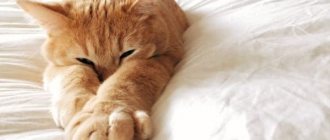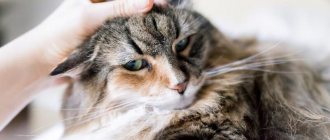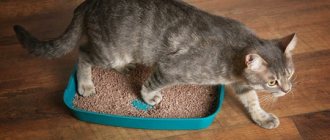In this article we will understand why a cat shits on the bed and how to correct this behavior of your pet.
- Check your pet's health
They say about cats that they walk on their own, hinting at their special character. A cat is not as easy to win over as a dog. Representatives of cats are more independent. Because of this, they are often attributed character traits that do not exist. For example, if a pet begins to shit in the wrong place, the owners may attribute it to harm. But animals do not know how to make plans for revenge; such behavior is associated either with stress or with health problems. Pay special attention to your pet’s health if your cat starts peeing on the bed and sofa unexpectedly and has never done anything like this before. Our experts examined the reasons in detail and also made recommendations on how to stop a cat from peeing on the bed.
Why does a cat shit on the bed?
Before selecting educational methods, it is important to understand why the cat stubbornly shits on the bed, avoiding the tray prepared for it.
Although some believe that this is how a pet expresses its resentment or is trying to take revenge, in fact, such behavior is explained by other objective reasons:
Dirty tray
The cat has a dirty litter box
A feature of cats is that they bury feces, which allows them to avoid attracting predators under natural conditions. Therefore, if a cat does not go into the tray, but tries to disguise its feces with the folds of the blanket, you should immediately check the cleanliness of the tray. You need to understand that the pet will not re-use an already used container that acts as a cat litter box.
Problems with the filler
Problems with the filler
An unfamiliar or unpleasant smell can serve as a deterrent signal for cats with their sensitive sense of smell. For this reason, the pet is able to avoid going to its litter box after replacing the usual litter with a different brand. The same reaction is often observed after the owners decide to completely abandon the use of filler. To make sure that your cat started defecating on the bed for this reason, you should return to your previous routine.
Consequences of stress
A common reason to understand why cats use their master's bed as a toilet is a stressful situation:
A pet experiences a negative psycho-emotional impact if it is transported to another home. The appearance of another pet in the house can cause serious concern. Fear manifests itself and is reinforced through physical punishment. Some cats react negatively to the appearance of a newborn in the house, to whom the attention of the household is maximally switched.
Diseases
The cat is sick
Sometimes cats shit themselves while climbing on the bed due to illness. If you notice this behavior, you need to examine the animal. Typically, puddles on the bedspread indicate the development of urolithiasis. Due to pain when urinating, the animal strives for soft surfaces to reduce unpleasant symptoms. Feces appear on the sleeping bed due to intestinal diseases of the cat.
Hormonal imbalance
Inappropriate behavior in animals is often observed during periods of hormonal fluctuations. Submitting to natural instinct, the female marks her territory during estrus. Therefore, odorous traces will be observed in different places.
Elderly age
An aging cat often goes to the toilet in different places, including on the bed, due to weakness and the presence of chronic diseases. Forgetfulness and loss of skills may occur. In such a situation, it is advisable to make a comfortable bed for your cat with your own hands, which can be easily washed.
Tray inaccessible
Tray inaccessible
Sometimes the owner, having decided to change the location of the cat’s toilet, rearranges its container. Most often, the animal does not immediately get used to such changes. A puddle may appear on the bed if the room in which the cat litter box is located is accidentally closed.
It should be taken into account that kittens, as well as non-sterilized animals, often use the sofa, carpet, bed and other inappropriate places to defecate. It is necessary to control a pet that has recently appeared in the house.
A cat shits on the bed - a folk sign
They say that among the people there is even a sign that determines that a cat pooping in the bed portends profit. According to another interpretation, this is a harbinger of illness in one of the household members.
Prevention of bad behavior
Bad behavior cannot be completely eradicated, and therefore it is recommended to simply make friends with the animal. To do this, it is recommended to follow certain recommendations:
- never shout or punish the animal in any way;
- play with your pet more often, show affection towards him;
- start feeding the pet if this action was previously performed by someone else;
- prohibit the animal from sitting on the bed, offering him an alternative such as a T-shirt or other clothing that has a human scent.
A cat, feeling safe around people, will not shit on the bed. However, this may resume when a new person or animal enters the home. You should be prepared for this and initially allow the animal to get used to the guest.
Punishment is never a good way to train animals to do anything. To consolidate positive results, you should use treats. It is recommended to be patient so that what you want is achieved.
Methods
Consider the following ways to stop a kitten from peeing on the bed:
- Remove the mattress cover and put it in the wash. You need to collect the liquid from the mattress itself as quickly as possible with a dry towel or napkins. Next, blot the surface of the mattress with them. Do not press or rub the stain to avoid pushing the liquid deeper.
- Eliminate pungent urine odor with vinegar. It will neutralize uric acid and eliminate its odor. Vinegar must be diluted with water in a ratio of 1:3 and sprayed onto the mattress from a spray bottle. If you don’t have a sprayer, apply the solution with a sponge, but immediately lay napkins over the treated stain so that they absorb excess moisture.
- Absorb any remaining moisture with regular baking soda. Sprinkle baking soda over the stain for 10-15 minutes and it will absorb any remaining vinegar solution and urine.
- Use hydrogen peroxide to remove stains from the surface of the mattress. Buy 100 ml of peroxide at the pharmacy and dilute it in 200 ml of water and shake well. Then, using a spray bottle or a sponge with napkins, apply the composition to the stain directly on top of the baking soda scattered over it. As a result of the chemical reaction between soda and peroxide, a thick and persistent foam should form. Leave it to act for 2 hours. The abundant oxygen released during the reaction effectively bleaches the stain.
- After 2 hours, blot the area where the stain was with dry wipes and vacuum thoroughly to remove the soda from the mattress. After such cleaning, you need to leave the mattress in a well-ventilated room for at least 10 hours to completely dry and remove the odors of soda and vinegar.
- Forbid your pet to sleep on the bed, evict him, it is better to close the door to the room.
- If there are several animals and it is not clear which of them is peeing, then this is determined using food coloring, which is harmless. Take bowls and put different dyes in them. You need to remember which cat ate what, then scan the wet area with a fluorescent lamp.
Use special products that neutralize odors. If the kitten does not smell its excrement, it will stop trying to make a puddle on the bed. Most likely he will try to find a tray or other secluded place.
Scare away the kitten with the help of the drug “Feliway”, buy it in pet stores and veterinary clinics. You need to spray the bed with this product. Out of a sense of self-preservation, the pet will not encroach on “foreign” territory. The smell is imperceptible to people.
How to save a sofa or bed from smell
Cat feces have a very pungent odor. If you do not remove it immediately after detection, then the cat will return to your bed for a very long time, guided by the marks left there.
What to wash clothes with
Remove the soiled laundry and wash it under the tap, thoroughly soaping it with laundry soap. Then put it in the washing machine, filling the corresponding compartments with powder, conditioner and odorant - a special product for eliminating unpleasant odors.
Remember to avoid using bleach and chlorine powders when washing. If you inhale these products, your cat may get a burn to the respiratory tract.
How to remove stains
To remove stains, use special products that remove uric acid. These include:
- alcohol and vodka;
- lemon juice or citric acid dissolved in boiled water;
- diluted vinegar;
- a solution of hydrogen peroxide and baking soda (suitable only for hard surfaces);
- a weak solution of potassium permanganate (suitable for dark, delicate fabrics).
Please note that perfume and cologne will not help here. They contain a very small amount of alcohol, so you will simply be wasting your favorite eau de toilette.
Help from essential oils
Representatives of the cat family cannot tolerate the aroma of citrus fruits, eucalyptus, lavender and fir. Essential oils from these plants are excellent for repelling baleen pests and do not require much consumption. For a lasting aroma, it is enough to apply just a couple of drops of the selected product to your bed linen.
Products from a pet store
In addition to household chemicals and folk remedies, special preparations from a pet store or veterinary pharmacy will be useful. Depending on their purpose, they have a repellent or attractive effect. The first option is suitable for keeping the cat away from your bed, and the second is for training him to use the litter box.
When you can't do without dry cleaning
If your pet is not neutered, then you will need a powerful professional dry cleaner. Also, you cannot do without it if pillows, blankets or mattresses are damaged. It is not recommended to wash all these items in a regular washing machine, as their filling can quickly become unusable.
Causes
The most common reasons why a cat starts peeing not in the litter box, but in the owner’s bed:
- Dirty tray. If your cat starts peeing on the bed, this may be due to insufficient cleanliness of the litter box. The animal instinctively shits in a certain place so as not to spread odors and pollute the home. An unclean litter box forces the cat to dirty in places that are most convenient for this from her point of view.
- Cleaning the tray at least once every 7 days will help prevent problems. You should not wash your cat's litter box using odorous products, as this may lead to litter box abandonment.
- Animal physiology. The cause of puddles and piles in the most unexpected places can be animal diseases. You need to look at the color of your urine and how often you urinate. If necessary, you will need to undergo tests and do an ultrasound. A correct diagnosis will help rid your pet of the disease and at the same time wean it from a bad habit.
- Age. A small kitten gets used to its toilet only at the age of one and a half months. An adult pet begins to do its business where it is more convenient for him in most cases due to the inconvenience of the tray, for example, if its sides are too high. Replacing the cat litter with a more convenient option will correct the current situation.
- Change of place of residence. Moving is stressful for a cat; everything new causes fear, but the owner’s bed is familiar and cozy. Patiently showing the tray to your pet will help solve the problem.
- Moreover, for the cat’s toilet it is necessary to choose the most comfortable place from the animal’s point of view. The tray should be located away from drafts and places where people constantly walk. The pet should also like the filler, because if the blanket on the bed suits the cat much more, then she will start to shit on it.
- Discord with other pets living in the house. Several animals living in the same territory invariably begin to find out who is boss in the house. The cat begins to pee in the owner's bed, demonstrating leadership, seeking protection, or complaining about oppression. If there is a dog living in the house, then the cat may begin to move away from communicating with it to the owner’s bed.
- A cat's affection for one of the people. This is rare, but when the owner leaves, the animal begins to get bored and the owner’s bed becomes his favorite place. As a result, the cat shits on it, thus feeling closeness to the person - this calms it down.
- Sometimes your pet demonstrates in this way how much she misses you. Punishment in this case is pointless; isolating the animal from the owner’s bed will help.
- Cat place. If an animal has chosen, for example, a sofa as its place, and the owners are constantly driving it out of there, then, not finding another place, the owner’s bed becomes the most suitable option for the cat.
- The cat marks its territory. The fight for territory is inherent in nature; in this case, only sterilization or castration can stop you from peeing on the bed. Thanks to this procedure, the animal's behavior changes dramatically.
- Character. The reason that a pet begins to pee or shit in its owner's bed can be jealousy. For example, if a lonely person has a soul mate, this may be interpreted by the animal as a betrayal. Sometimes, if there are other pets, the cat may pee just to replace their scent with her own.
shutterstock
How to keep your bed dry?
So, you have clarified what the reasons for misbehavior may be and are ready to work on correcting the latter, where to start? Here are some tips:
- Change your bed linen, it is important that the texture of the new linen is different. If necessary, fold your laundry every day and put it in a bag.
- Change the blanket you use to cover your bed - this is very important! Do not wash the old one, but use the new one. Choose a completely different fabric structure, for example, if the cat likes flannelette, take prickly wool, replace slippery fabrics with cotton ones, etc.
- While the problems with the tray are being resolved, cover the bed with film, preferably so that it rustles loudly. You can use garbage bags sealed with tape. If a cat pees on oilcloth, its paws will be wet - and this is a good reason not to repeat what it did.
- Strengthen the association “a bed is not a toilet” by taking your pet to sleep with you or playing on the bed. Once your cat begins to think of the bed as a nest, she will lose the desire to get it dirty.
- Place a litter box in the bedroom (temporarily) - this method is especially effective if you have other animals in the house. It is quite possible that the cat is simply uncomfortable making its way through the territory of its roommate to the litter box.
- Buy another tray, it may be uncomfortable for the cat to go big and small in one place.
- If the reason is jealousy towards the other half, the newly arrived family member needs to make an effort on himself and forget wet grievances. A stranger will become a friend if he feeds the cat and plays with it, not right away, but over time everything will work out.
Why such problems may occur
If your cat starts shitting anywhere, don’t rush to run to the veterinary pharmacy for a spray or look for all sorts of folk remedies. Remember, cats are clean animals, and if you train them to use the litter box, they will go there. However, incidents can also happen when the pet seems to be accustomed, but suddenly “traces” begin to appear throughout the apartment. Why did it happen? Let's look at several reasons.
The cat is uncomfortable in the litter box. If she doesn’t like, for example, the smell of the litter, she won’t go there. If the structure of the filler does not suit her, she will not go into the tray. Moreover, if for some reason she simply did not like the toilet as a design, the result will be the same. This is the first step to take to prevent “surprises” in the bed and in the corners; disease of the genitourinary system or gastrointestinal tract. If a cat experiences pain when defecating or urinating, it will quickly form a negative association with the litter box and will try to “solve the problem” on its own. The methods preferred by the animal are not always pleasant to the owner. If maneuvers with the tray do not help, visit a veterinarian; protest
Cats are perhaps the most cunning and most vindictive pets! If you stop paying attention to the animal, it will attract it in all sorts of ways. Yes, cats can also be offended by the owner, trying to remember the offense for refusing to hold him in his arms, feed him once again, play, take a walk, or do anything else that the animal is accustomed to.
reflex bowel movement. Cats may have more than just negative associations with the litter box. It happens the other way around, if a certain object reminds an animal of a tray by smell or by some other sign, the pet can go there simply reflexively; age factor. This is especially true for older animals that may suffer from memory problems.
Common diseases
Before “passing judgment” on a “naughty” pet, the owner should take a closer look at it. Perhaps the cat is not taking revenge or causing mischief at all, but is sick. Often it is enough to take tests and undergo an ultrasound examination at a veterinary clinic to identify a disease that is causing the pet to walk “smallly” in the wrong place.
Main reasons. The main causes of puddles in bed and other inappropriate places are inflammation of the bladder and urolithiasis. These pathologies are accompanied by severe cutting pain, so the cat cannot fully move and find a convenient place for the toilet.
Other factors. In addition, there are other pathologies and diseases that affect the urination process of furry purrs:
- Disturbances in the development of the genitourinary system . In this case, the pet, while still a kitten, cannot get used to the tray. As a rule, no measures help and mandatory consultation with a specialist and appropriate examination are required.
- Diseases caused by infection . Impaired urination is a symptom of cystitis, urocystitis, panleukopenia, nephritis, nephrosis. In addition, it can signal such a dangerous cat disease as mycoplasmosis, which affects the animal’s liver and other vital organs.
- Malfunctions of the central nervous system . Often, as a result of injuries and inflammatory processes in the brain, this area of the body is damaged, and the animal begins to suffer from incontinence.
- Metabolic disorders . They affect not only the functioning of the genitourinary system, but also lead to animal obesity and the development of diabetes mellitus.
- Labor activity. Often, furry pets choose the owner’s cozy and warm bed as a place to give birth. During labor, a certain amount of fluid may be released from a full bladder - from a few drops to a decent-sized puddle.
Extraordinary and reliable measures to stop your cat from shitting on the bed
Before you understand and figure out why a cat shits on the bed, you can try to take quick measures to eliminate the animal’s desire to relieve itself where it is prohibited.
The aroma of lavender will help stop your cat from shitting on the bed.
These methods (measures) are:
- Using the scent of lavender as a deterrent. Cats really don't like its scent, so it is recommended to use fabric softener after washing clothes with this scent. In addition, it is also recommended to purchase a bottle of lavender oil at the pharmacy and apply a couple of drops to the head of the sleeping bed.
- Close the doors to the bedroom tightly so that the cat cannot get in.
- Use a soft cloth to gently wipe your cat's neck and tonsils, and then use the same cloth to wipe vertical and horizontal surfaces in the house where the animal likes to mark its territory. These areas, behind the ears and under the neck, are where cats produce the most pheromones. Therefore, if you take care in advance and indicate at a very subtle level the smell of the animal where it is necessary, you can be sure that the pet will not do this on its own later.
If, for example, the smell of lavender and a closed door does not help, then as a punishment (the main thing is when it is directly discovered at the crime scene!), and not after discovering a “surprise,” you should give the animal a light slap with a rolled-up newspaper.
Maintain constant cleanliness not only in the pet’s tray, but also in those places where the animal’s foreign smell prevents him from living peacefully
Try to use air fresheners and deodorants as little as possible; cats are very susceptible to laundry detergents. Do not give the animal a reason to drown out its marks in the form of piles and puddles from other people's odors. Maintain constant cleanliness not only in your pet’s litter box, but also in those places where foreign odors interfere with the animal’s ability to live peacefully.
As another way to wean a cat from going to the toilet where it is not supposed to, the technique of placing bowls of food or pieces of dry food on cardboard in “favorite” places can be used. The cat will not shit where it eats.
The main thing is to understand and understand the reason why the cat shits on the bed, and it is quite possible to solve the problem in 5-10 minutes. A self-confident cat, with a properly selected method of education, is the key to peace and comfort in the home.
You should always carefully monitor the animal’s health and, if necessary, contact a veterinarian
Don't forget the smell and peace, i.e.
the absence of stress and the attention of the owner play a huge role for the cat, and the pet’s health should always be carefully monitored, promptly receiving advice from a veterinarian. Love, care and perseverance in parenting work wonders
Remember this, and you will definitely succeed.
Why does my cat constantly shit on the bed? was last modified: September 16th, 2021 by Maxim Bartsev
Any cat owner will confirm: there is no creature more capricious and vindictive than this furry creature. Cat love, like hatred, sometimes takes on very strange forms that can turn the life of all the inhabitants of the house into real hell.
Such manifestations include puddles and piles left by the little monster right on the owner’s bed. Why does a cat shit on the bed, and most importantly, why don’t any penal measures work on everyone’s favorite cat, who stubbornly continues to spoil linen, pillows and mattresses?
Ways to solve the problem
There are several recommendations on how to wean an animal from peeing on the master’s bed or sofa:
The best thing to do is to start weaning immediately after the first puddle that appears. You need to buy a special tray and filler that eliminates odors. An alternative to filler would be pieces of ordinary newspaper. A specific place must be allocated for the tray. You cannot change the location of the cat litter box, as the kitten must remember its location; searching for the litter box will lead to the appearance of new puddles. It is necessary to carefully monitor the baby, as soon as he climbs onto the bed to pee, you should pick him up and take him to the tray. The kitten must pee there, after which it must be praised. If a small pet has managed to do its job on the bed, it should still be taken to the tray, but kindness and affection cannot be demonstrated. You need to show dissatisfaction with his behavior by leaving him in the cat litter box to “think about your action.” Until the kitten gets used to the litter box, you should limit access to the kitten's bed. That is, the door to the bedroom should be constantly closed. This is necessary to wean your baby from peeing on the bed. You need to make sure that the kitten does not leave the tray until he has done his business in it.
This will speed up the process of getting used to the toilet. It is important that access to the tray is always free and the kitten can use it at any convenient time. The tray should be comfortable, long, deep (but in moderation) and spacious enough so that the pet can turn around in it without difficulty. Representatives of the cat family have a developed sense of smell 10 times better than that of humans. Therefore, cheap plastic with the strong aroma of chemicals emanating from it can cause disgust in a kitten. For kittens that are too clean, you can install two toilets.
Following the described recommendations will help to wean the kitten from peeing in the owner’s bed and at the same time understand what the tray is for, remember its location and get used to it. In most cases, kittens learn easily, are smart, and if you do everything correctly, the results will not keep you waiting and the pet will begin to go to the place strictly designated for this.
Cleanliness and force of habit
Just like people, cats have their own preferences, which also apply to the toilet. When organizing a “latrine”, the owner should pay close attention to various details:
- Regardless of the shape, size and type of filler, the tray must be clean . Many owners note that their pets do not go to the toilet if there is even a “hint” of previous bowel movements in it. Some cats furiously “bury” the puddle until the owner cleans it up. Such “cleanliness” is, rather, caution. Indeed, in nature, feces and urine “give away” animals and can bring “uninvited”, dangerous guests into the lair. However, for most animals, it is enough for the tray to be cleaned regularly and the litter to be partially replaced. In this case, once a week it is necessary to completely replace the material and thoroughly clean the container itself.
- Tray size . Often, owners, having once bought a litter box for a kitten, forget to replace it with a larger container. It becomes very problematic for a significantly older cat to “relieve” itself on the “children’s potty”, and he goes in search of a more convenient place. The tray should be long enough and moderately deep so that the cat can turn around in it and rake in the way it is comfortable for her. There are also rough estimates on this score - the length of a suitable container is 50% greater than the length of the animal’s body. Of course, the tail is not taken into account in this case.
- Tray location . Most cats value comfort and privacy, which means it is recommended to place the litter tray away from drafts and prying eyes. Particularly shy individuals require closed containers equipped with walls and a lid. As a rule, a suitable tank is selected empirically, based on the individual preferences of the pet.
- Number of trays . If the animal is extremely clean, then experienced owners advise placing 2 containers at once. The latter is especially important when the owner is often away from home for a long time and cannot clean the litter box every time the pet goes into it. Two cats will need 2-3 trays, and three cats will need 3-4...
- Cleaning with disinfectants. Chlorine-containing products and a vinegar solution work well against odors, urinary stone deposits and various pathogens. However, these same products have a pungent odor and are often used to stop a cat from peeing anywhere. What to do in this case? First of all, you should wash the tray regularly using regular laundry soap, rinse it thoroughly and wipe it dry. If you do this in a timely manner, the container will remain clean without any signs of stone or “bad amber.”
Which cats are more likely to shit on the sofa?
Older animals have their own body characteristics. Often, as a cat ages, those reflexes that have been developed during life are suppressed. This is due to lower metabolic processes and gradual degeneration of nervous tissue. Also, permanent changes in the body of old cats occur with the genitourinary system. Older cats are more likely to have incontinence problems due to weakened pelvic muscles. Therefore, older animals can shit on the sofa due to health problems.
Old cats may forget where to relieve themselves
Non-sterile animals have more unbalanced hormonal levels. And this behavior is due to changes in the levels of various sex hormones. In addition, when a cat is not sterilized, he has a physiological attraction to the opposite sex. This includes both the mating season and the estrus period.
Note! In such an excited state, the animal simply has no time to think about where to relieve himself and where not.
Territory marker
The most common reason for the appearance of “fragrant surprises” outside the tray is a territory mark. Most often, males “sin” with this, doing this all year round. But females, at certain moments in life, can begin to “mark” corners, furniture and other places that are important, from their point of view. This behavior is mainly observed in cats during estrus.
Sterilization. It is impossible to wean your pet from this behavior, but the problem can be solved by sterilization. True, you shouldn’t expect lightning-fast results:
- Even after a successful procedure, the animal requires several days to recover. And before that, the pet may not have time to get to the tray.
- Neutered cats often continue to leave marks in their homes. This is due to the fact that changes in hormonal levels require a certain time, most often several weeks. But when everything stabilizes, the pet will forget about the “bad habit.”
- It is very important to seek qualified help. After all, if the operation is performed by an inexperienced specialist, then the risks of developing postoperative complications, for example, urinary incontinence, are high.
It is recommended to spay and neuter your pets before they reach sexual maturity. Cats - until the first emptying, cats - before the start of sexual hunting.
This is interesting: How to give Milbemax to a cat?











